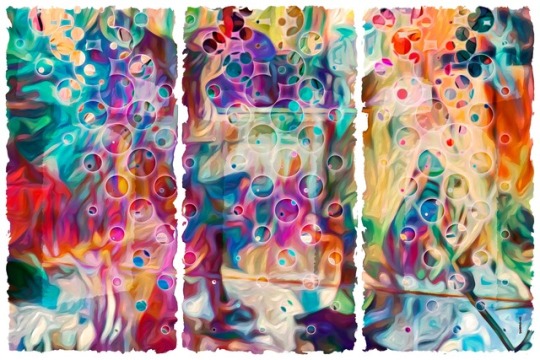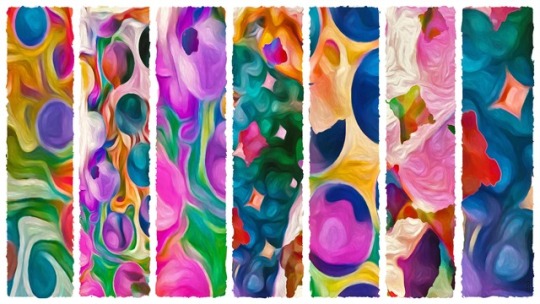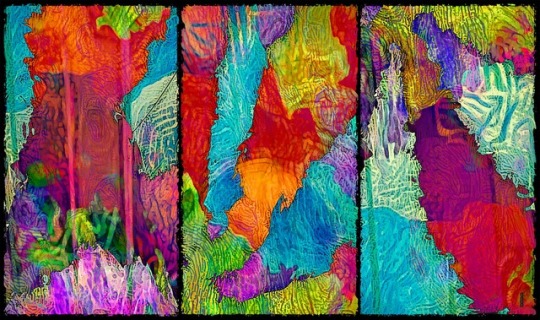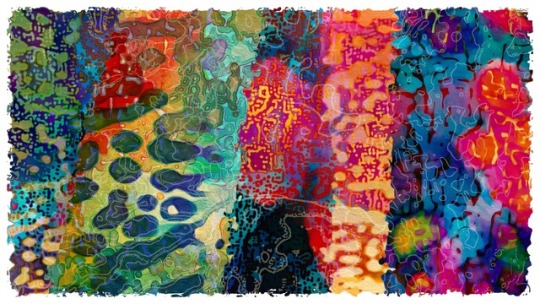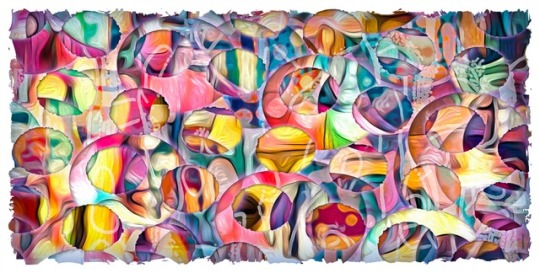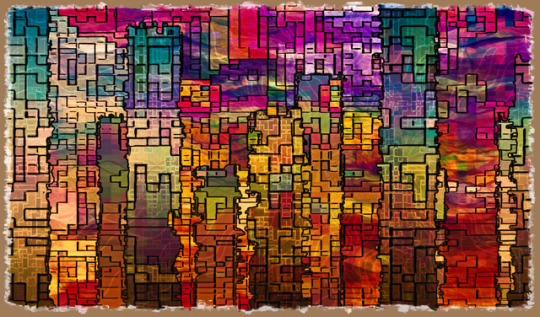#Apophänie
Text

1 note
·
View note
Text

[Post-it] Suite d'idées
Le jour de l'apophénie · Voyage en février 2012 · Photos reçues le 12.12.2021 · Mer Baltique · 2012/2021/9ans
« [...] même si les lois de la physique font que la date et l'heure de l'horodatage ne peuvent qu'être postérieures à l'instant en question. »
0 notes
Quote
Apophenia (/æpoʊˈfiːniə/) is the tendency to mistakenly perceive connections and meaning between unrelated things. The term (German: Apophänie) was coined by psychiatrist Klaus Conrad in his 1958 publication on the beginning stages of schizophrenia. He defined it as "unmotivated seeing of connections [accompanied by] a specific feeling of abnormal meaningfulness". He described the early stages of delusional thought as self-referential, over-interpretations of actual sensory perceptions, as opposed to hallucinations.
Wikipedia
62 notes
·
View notes
Text
Apophenia (/æpoʊˈfiːniə/) is the tendency to perceive meaningful connections between seemingly unrelated things. The term (German: Apophänie) was coined by psychiatrist Klaus Conrad in his 1958 publication on the beginning stages of schizophrenia.
1 note
·
View note
Text
1
"English is boobytrapped," Walter muttered, his thought racing through a constellation of references. Among decades of clips of amalgamated faces saying "boobytrap", Data from The Goonies was the clearest. Faces from countless movies, TV shows, video games, even YouTube. They're always laughing, shouting, or saying "boobytrap" of course. When they shout it's all in vowels, like the teacher in Peanuts having a bad day.
Tha why sem! Sem sem boobytraps!
"No. It's not a constellation, it's a solar system. The astrophysical model is a metaphor for memory. Data is the vividest memory associated with boobytrap so in this particular solar system Data is the Sun. He has the largest mass therefore the greatest gravitational pull. The other memories are planets and miscellaneous celestial bodies, all of which are too faint to recognize because they're obscured by the Sun. But they're on the tip of my tongue, dammit!" He had stopped sweeping.
"And they're not references. I haven't decided what to call them. Associative Echoes? No, they all end up sounding like rejected Pink Floyd album titles."
English is boobytrapped. Perhaps a lexicographer’s idea of an inside-joke, but for a schizophrenic prone to etymological flights of fancy it is catastrophe lying in wait.
Apophony1 is a linguistic concept. Sounds within words can change to indicate grammatical information, usually with vowels. Words like sang, sing, song, sung; or bind, bound; tooth, teeth. That’s apophony. The term was probably coined by Jacob Grimm2 in his seminal study of the German language, Deutsch Grammatik, published in 1819 and arguably the catalyst for what became Linguistics. Writing in his native German, Grimm used the spelling ‘Apophonie’ citing Ancient Greek3 as the source of his neologism. Somewhere between German of 1819 and English of 2018 the word for “meaningful sound-changes in words” underwent a meaningful sound-change of its own. Is that apophony?4
Apophany is a psychiatric concept. In contrast to an epiphany, the German ‘Apophänie’ was coined in 1958 by psychiatrist Klaus Conrad as the tendency to perceive meaningful connections where there are none. More words of varying degrees of interrelation, each distinguished by meaningful sound-changes.
"Correct, these also contain sound-changes, although they're subtle. It's probably a different concept. If not, it should be. How did you find out about apophany?"
I was reading about apophony on WikiPedia. At the top of the article right under the title it says 'Not to be confused with Apophenia.' That last word links to its eponymous article, so I clicked on it.
"And what is your interest in apophony?"
Someone should make a disambiguation page. You know when you're looking something up on WikiPedia, say phoenix, and instead of taking you to the article on Phoenix, Arizona it takes you to this huge list of mythological birds or businesses, books, albums, military vehicles... all with the name Phoenix?
"Sounds familiar."
And, if you search 'disambiguation' it takes you to a Disambiguation page -- for disambiguation! At the very bottom of the page it says:

The word that refers to identifying which meaning of a word is used needs help identifying which meaning of itself is used? What is that page, the Singularity? You should go there. E-N dot wikipedia dot org slash wiki slash disambiguation (capital D) underscore open parenthese disambiguation (little d) close parenthese5.
"I'll do that." No you won't. "You haven't answered my question."
I was researching vowels. They're very telling. English has turned them all on their head, especially in North America. And there you go! It's geography.
"What is geography?"
The vowels -- one thing they reveal very reliably is where the speaker comes from. In the States there are many regional accents, each with their own subcategories of local accents and dialects. For example, take the word Hi. I speak American English with a non-regional accent so I pronounce it with two vowels in rapid succession: a - the open front unrounded vowel and ɪ - the near-close near-front unrounded vowel. Together they sound how way we say 'eye'. But I grew up in Texas where many have a Texan accent which, as any Texan will tell you, is distinct among accents of the American south. A typical Texan accent will say Hi with æ - the near-open front unrounded vowel. That's the A-sound in the word 'cat'.
"Why were you researching vowels?"
Because they're all arbitrary! Ay, ee, eye, oh, you? For every vowel -- even 'Y' -- there's at least one English word spelled with one vowel but pronounced with another.
"Such as?" Like --
Just because I can't think of an example off the top of my head doesn't invalidate my point! "Settle down."
"Just take your time and gather your thoughts. Think it through and you'll find it."
'Women'? That's two I-sounds. There are no I's in women. (The letter).
"Speaking of women, if we always pronounced the 'O' the way we do in the word 'one' we'd spell women O-M-E-N."
And the ə?6 The most common vowel in the English language is the sound "uh" and it's not even in the alphabet. It's an upside-down lower-case 'e' which can be misread as a lower-case 'a' -- especially if it's handwritten -- which is ironic because it's also how we pronounce the indefinite article 'a'.
"Most of the time. Why does it matter if vowels are arbitrary?"
They're only arbitrary in how we perceive them. For the coiners all vowels serve the same function, so in that sense they're arbitrary. They use the vowel's periodicity as a tuning reference, optimizing their vocal chords and alveoli for sympathetic resonance.
"That's the group you've been talking about? The Coiners? The ones who can read a person's mind by hearing what, their vowels?"
Of course not. Ideally they use the gestalt of speech and speaker. But they'll have a good head start with nothing more than an 'Um'. There are vowels but there's also consonants, prosody, inflection, pitch, register, amplitude. Each has a part to play but the vowels are the crux of it. But, if the coiner hears their name? That's more information than they'll ever need. A name spoken by it's owner is the densest signature you're gonna get out of them.
"Focus on the vowels. You were researching vowels and at some point in your research you arrived at the Wiki page for apophony. How did you arrive there?"
I was suspicious of them. The vowels. It was years ago when I first noticed how random their usage in English is. Doesn't everyone at some point? I can recall a general sense of confusion about all this from vague memories dating back to elementary school! But more recently I was doing deep-dive etymologies on Wiktionary -- that's WikiPedia's dictionary. Wiktionary is unique in that any definable combination of letters has a dedicated page. But unlike WikiPedia where they route any confusion through a disambiguation page, all available lexicographical and etymological data about that combo of letters are presented on that same page for all languages in which that combination occurs. That's unprecedented and it's fucking digital to boot. And, for each entry in English a table of translations is provided in as many languages as possible -- and if the original English word has multiple definitions, each definition is given its own table of translations. This would've required searching through stacks and stacks of books and cross-referencing so many terms that a team of linguists would need hours to collect a fraction of what I can review in mere seconds, all for a single word. Armed with a freakish curiosity one can drill down quite far. I'm convinced that without this resource I never would've discovered them.
"Discovered who?"
Not who, what. The Prime Consonants. Sorry, I really should have started with these. They're the main takeaway from all of this.
"Not the vowels?"
Yes and no. There are eight Prime Consonants all of which require the Ürvokal7 for articulation. The Ürvokal is breath, symbolized by the letter 'H'. Speech requires breath and 'H' is articulated by literally exhaling.8 So, when reducing words down to their Primes you discard all the vowels. At that level they truly are arbitrary. Low-level programming uses only consonants, like an organic version of Assembly.
"What are the eight Consonants?"
The eight Prime Consonants are B,K,L,M,N,R,S and T. But those aren't exactly letters I'm naming... While they do refer to the letters themselves, they symbolize the prime-states of glyph, phoneme, mechanical articulation, and ordinality with regards to acquisition.
"There must be fifty different scenes from movies with the nerdy expert explaining the imminent catastrophe to the beefcake hero and the latter snaps at the former 'In ENGLISH please?!?'"
Walter froze as his voice's echo decayed down the corridor. Overcome by a wave of embarrassment, he clutched at his broom awaiting any sign he'd been heard while nervously rewinding the conversation back in his head, worrying he'd been speaking out loud for some time... The click of the clock's minute-hand snapped him out of it as he slowly inhaled, teething his bottom lip. "Watch it!" He was whispering now.
"What do you mean 'in English?' You know this stuff just as well as I do!"
But you know how irresistible the urge is to share -- what did you call them? Associative echoes? Plus, considering the topic I didn't want to upset you. "By shouting it out loud?!" I was quoting!
Another echo but with a much quicker decay. Walter was whispering but still managed to get quite loud. A firm whisk of his broom provided an effective mask, but he was alone.
"It's called a stage whisper. And it decayed quicker because it's all high-frequency noise which is high-velocity, high-energy. It's short-lived! You were saying something about symbolizing prime-states at which point you lost me."
Prime-states - in general, you think of each prime as their respective letter and sound and that's also how we'll think of them here most of the time, while doing our reductions. But then there's the physical mechanics of actually rendering the phoneme. These dictate when a person acquires the ability to correctly speak each sound during their childhood development. All of these factors influenced the selection of the eight Primes. So when I refer to the prime 'B' or 'N', for example, I mean the glyph and it's variations; the sound (prime consonants only have one phoneme); the mechanics of producing the sound (especially in the context of other sounds); and the timeline of when each phoneme is acquired by the speaker. From all this we reduced the alphabet down to these eight letters. Every single word in every single language of Western Civilization can be reduced down to a combination of these eight letters.
"I still don't get what all this has to do with apophony."
Apophony is the mutability of vowels inside of a word, which proves that the essence of the word lies in its consonants. There are twenty-one consonants in the English alphabet. Thirteen of those are derivative of the eight Pr-- Hang on. Five vowels, eight prime consonants, thirteen derived consonants, twenty-one total consonants?
"Those are Fibonacci numbers!" Walter was bending back four fingers against the broomstick, demonstrating his unusually extreme double-jointedness which had been a reliable party trick in undergrad.
"But what about 'H'?" What about it? "I thought it was a separate, more fundamental letter/sound. Wouldn't that corrupt the sequence of Fibonacci numbers?" Not necessarily. It's a single letter, right? It could be the one at the beginning of the sequence. "What about the other one?" It's both! "The inhale/exhale! YESSS -- like the tchetchragrammatchron," Walter growled softly through clenched teeth. It was partly the surge of excitement but also to throw off eavesdroppers, knowing perfectly well that no one was within earshot.9
There is something hidden in human language. Human communication, really.
"That's your goal? To find it?"
That's impossible. An individual is incapable of finding it alone, it's too much data. You know why they invented chaos theory? Weather. Meteorology as we know it exists because of chaos theory. At the dawn of the Cold War governments suddenly had grave concerns about weather prediction. After all, they needed to be absolutely certain their missiles wouldn't fly off course due to some freak storm and, God forbid, detonate in friendly territory. Their mathematicians realized that to make predictions within an acceptable margin of error required plotting the behaviors of virtually every particle in the atmosphere. This is an immeasurable, uncountable quantity, an obvious nonstarter. Ed Lorenz stumbled upon the answer, but his stroke of genius was to think of the stump in the first place: he built a simplified mathematical model of the atmosphere. He figured there's only one way to count the uncountable: you approximate. Without those initial conditions, who knows if we'd have even made it this far.
"So you hope to what, crowdsource the computational power?"
That's an interesting way to put it. But it's more than just processing power. You'd have to crowdsource the data, which may be a catch-22.
"How so?"
Because it would have to be open source. But unlike the Wiki sites with entire communities moderating content to conform to strict rules of style and verifiability, this has to be different because it's a value-neutral system. As far as its concerned, trolling of WikiPedia articles is just as valid as the articles that say the sky is blue and water is wet. These are all expressions of human culture through the medium of language.10 That's like the OED handing the reins over to Urban Dictionary. Can you imagine?
"I can."
It's hard to know how to even classify the data before we start collecting it. The only solution I can surmise is to train a deep-learning neural network in parallel with the data-mining efforts. The first generations of neurons would inform the best way to proceed, in theory.
"AI? I think the internet has made you overestimate your capacity to acquire new skills." It definitely has. That's what landed me in here -- bit off more than I can chew. What's that Robert Frost quote? Itch Robert Browning. "I guess both apply. More boobytraps?" There's only one -- on WikiPedia.
"The Disambiguation Singularity Page?"
No, that's just a sad joke. It's the apophony/-phany paradox. Like I said, there's something hidden in the language and apophony is a symptom. It is a key to finding what lies beneath all communication. But according to experts, it's my theory about meaningful sound-changes in words that's the real symptom, a symptom of schizophrenia called apophenia. And my discovery about apophony was an apophany, an instance of apophenia. So my theory about apophony is wrong and its wrongness can be expressed by a word that just happens to resemble subjecting the word 'apophony' to itself.
"In this case two wrongs kind of make you right. Right?"
Maybe.
Also known as ablaut, vowel gradation, vowel mutation, alternation, internal modification, stem modification, stem alternation, replacive morphology, stem mutation, internal inflection etc. ↩︎
Of Grimm's Fairy Tales fame. ↩︎
ἀπό (from, out of, because of) with φωνή (sound, voice) ↩︎
"No. This is a change of spelling, not sound. This is an altogether different linguistic concept. It probably has a long list of names, too. Like a monarch, or a heavyweight boxer." Since no one can agree on a name I'm just gonna call it apophony because if it's written it's spoken, too. "That doesn't make sense." ↩︎
http://en.wikipedia.org/wiki/Disambiguation_(disambiguation) ↩︎
schwa ↩︎
German neologism, translates to Proto-Vowel ↩︎
To be precise, the Proto-Vowel is exhaled air. Inhaling is another topic altogether. ↩︎
Note to self: figure out 2 and 3. ↩︎
In one sense, the system actually values the trolling even more than the self-evident stuff. The trolling is loaded with so much cultural baggage, unpacking it reveals vast channels of non-periodic flow. ↩︎
6 notes
·
View notes
Text
apophenia - psychosis
“I am using a good old method called apophenia. Apophenia is defined as the perception of patterns within random data. The most common examples are people seeing faces in clouds or on the moon. Apophenia is about “drawing connections and conclusions from sources with no direct connection other than their indissoluble perceptual simultaneity,” [12]

google deep dream AI produces apophenic imagery https://images.e-flux-systems.com/2016_04_spaghetti-meatballs-become-really-frighteningWEB.jpg,2000
an interesting parallele can be drawn to psychosis, where sufferers can have the sense of meaning within random things i.e. the arrangement of flowers in the flower store. relating to the picture above is following quote
The clinical implications of this purely virtual status of the gaze (and the voice) are thus clear: what characterizes psychosis, the psychotic experience, is that this gaze is precisely no longer a virtual Real but falls into perceptible reality—a psychotic can “see” the object gaze (or “hear” the object voice).
is society psychotic? is google psychotic?
another interesting link is art, “visionary thinking”, the mystic and magic - all in some way tools, that we can use to access and work with concepts that are beyond our language and thinking - the same realm where some psychotics seem to dwell
apophenia (n.)
"tendency to perceive meaningful connections between unrelated things," 1961, from German Apophänie, said to have been coined 1958 by psychiatrist Klaus Conrad, from Greek apophainein "to show, make known, show by reasoning, produce evidence," from apo- "from" (see apo-) + phainein " to show, cause to appear" (from PIE root *bha- (1) "to shine").
0 notes
Text
Apophenia (/æpoʊˈfiːniə/) is the tendency to attribute meaning to perceived connections or patterns between seemingly unrelated things. Confirmation bias is a variation of apophenia.
The term (German: Apophänie) was coined by psychiatrist Klaus Conrad in his 1958 publication on the beginning stages of schizophrenia. He defined it as "unmotivated seeing of connections [accompanied by] a specific feeling of abnormal meaningfulness". He described the early stages of delusional thought as self-referential, over-interpretations of actual sensory perceptions, as opposed to hallucinations.
Confirmation bias
Confirmation bias is often seen as the direct influence of desire or beliefs. It is the tendency to search for or interpret information in a way that confirms a person's preconceptions or the hypothesis that they intend to put forth. This can often lead to people seeing clusters or patterns in data sometimes inadvertently to prove their ideas.
1] It is a type of cognitive bias and a systematic error of inductive reasoning. People display this bias when they gather or remember information selectively, or when they interpret it in a biased way. The effect is stronger for emotionally charged issues and for deeply entrenched beliefs.
People also tend to interpret ambiguous evidence as supporting their existing position. Biased search, interpretation and memory have been invoked to explain attitude polarization (when a disagreement becomes more extreme even though the different parties are exposed to the same evidence), belief perseverance (when beliefs persist after the evidence for them is shown to be false), the irrational primacy effect (a greater reliance on information encountered early in a series) and illusory correlation (when people falsely perceive an association between two events or situations).
[B]eliefs can survive potent logical or empirical challenges. They can survive and even be bolstered by evidence that most uncommitted observers would agree logically demands some weakening of such beliefs. They can even survive the total destruction of their original evidential bases.
—Lee Ross and Craig Anderson
21 notes
·
View notes
Text
Apophenia (/æpoʊˈfiːniə/) is the tendency to perceive meaningful connections between unrelated things.[1] The term (German: Apophänie) was coined by psychiatrist Klaus Conrad in his 1958 publication on the beginning stages of schizophrenia.[2] He defined it as "unmotivated seeing of connections [accompanied by] a specific feeling of abnormal meaningfulness".[3][4] He described the early stages of delusional thought as self-referential, over-interpretations of actual sensory perceptions, as opposed to hallucinations.[1][5]
Apophenia has come to imply a human propensity to seek patterns in random information, such as gambling.[4]
0 notes
Text
Có một ranh giới mỏng manh giữa Tư duy ma thuật và Bệnh tâm thần - Jen Maidenberg
(9 min read, 3K claps)
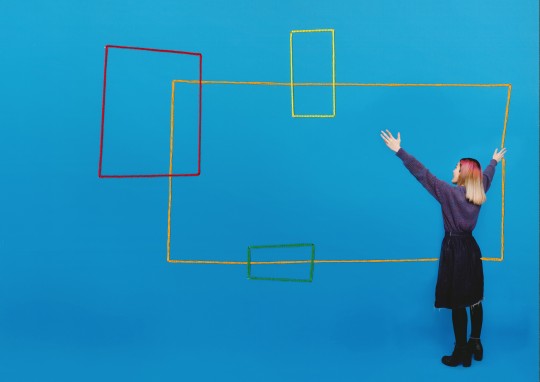
Đêm hôm trước, khi tôi đang tìm kiếm cụm từ “the significance of 38″ trên internet, tôi đã dừng lại ở trang tr�� lời của Yahoo!. Và thật sự đây không phải lần đầu tiên tôi cảm thấy thoải mái như vậy khi thấy được một câu trả lời từ một người lạ đối với một câu hỏi của người lạ khác.
Trên thực tế, thông tin hữu ích nhất mà tôi có thể tìm kiếm một cách hữu ích nhất từ internet đó là từ các bảng tin, từ những người có câu hỏi mà các chuyên gia không thể trả lời hoặc từ những người có câu hỏi không có chuyên gia được chỉ định. (Thực tế điều này hiện nay vô cùng phổ biến, có 837 triệu kết quả tìm kiếm cho Bằng cấp của tôi là từ Đại học Google.
Câu hỏi mà tôi có đêm qua nó nằm ở ranh giới này. Trong thực tế, bản chất của câu hỏi có liên quan đến câu trả lời cuối cùng mà tôi tìm thấy trên Yahoo.
Khi tôi gõ tìm kiếm “the significance of 38”, tôi không tìm điều gì liên quan đến thần số học cả, mặc dù việc đó có thể phù hợp nhiều hơn với tình huống khó xử của tôi bây giờ. Tôi thực sự không biết mình đang hy vọng tìm thấy điều gì, nhưng tôi đã nhận được một tin nhắn có chứa “38″ được viết bởi John Titor - một người tự xưng là du hành thời gian đến từ năm 2036 - tôi đã rất phấn khích.
Những gì tôi tìm thấy chỉ là các trang web và một trang tên Angel Number, cho đến khi tôi scroll đến một kết quả có tiêu đề: “Tại sao tôi cứ nhìn thấy số 38 ở mọi nơi?”
Đây chính cũng là câu hỏi của tôi, vì vậy tôi đã ấn vào link để xem.
* * *
Quay trở về sáu tháng trước đây, tôi đã có một giấc mơ, trong giấc mơ đó có một dãy số với 6 chữ số. Buổi sáng sau đó thức dậy, tôi đã note lại nó, và đó là việc tôi luôn làm trong suốt 2 năm qua.
Tôi đã bắt đầu sáng hôm đó vì tôi luôn mơ thấy tương lai. Nhiều giấc mơ biến thành sự thật vào ngày hôm sau, hoặc 3 ngày sau, hoặc thậm chí là sau một tuần trôi qua. Và tôi có đủ bằng chứng mạnh mẽ để chỉ ra rằng những chuyện này hoàn toàn là có thật và đây là một điều mà - đến chính bản thân các nhà khoa học cũng đang nghiên cứu hiện tượng này - thật sự rất vui khi có thể theo dõi giấc mơ của mình hàng ngày và sau đó có thể to tiếng thông báo niềm vui với bất kỳ ai khi một trong số chúng trở thành sự thật.
Tôi đã học được rằng khi giấc mơ của tôi chứa một con số nào đó, tôi nên viết chúng ra. Thông thường, một chữ số một hoặc hai chữ số xuất hiện trong giấc mơ ở dạng hơi khác so với trong cuộc sống khi bạn thức giấc - như hóa đơn, số tuyến xe buýt hoặc địa chỉ nào đó. Mơ thấy một dãy số 6 chữ số xuất hiện có vẻ ấn tượng, và thậm chí bằng chứng là tôi đã trở nên tốt hơn sau những giấc mơ về tâm linh.
Tôi nhớ lúc đó mình đã nghĩ rằng, “Tôi có điên hay không khi tôi tin cô ấy, hay tôi tin chỉ đơn giản vì đó là điều mà tôi muốn?” ” (chú ý câu chuyện phía sau dẫn đến câu nói này).
Trong giấc mơ đặc biệt này, tôi đã mơ đến một dãy số như số điện thoại, nhưng sáng hôm sau tôi chỉ nhớ một phần của nó:
Có 295, và tôi nghĩ là 295389 gì đó.
Ba ngày sau, tôi phải lái xe đưa mẹ tôi đến một cuộc hẹn với bác sĩ. Nhà để xe tự nhiên hôm nay đông đúc một cách lạ thường, và bãi đậu xe thì miễn phí. Khi tôi ra khỏi xe và tiến tới lấy vé, tôi có cảm giác gì đó. Oh, vé ghi 389-292. Tôi cười và cảm ơn người phục vụ. Tôi nói với mẹ tôi, người đã từng không tin tôi. Và bạn cũng có thể như thế. Bạn có thể chỉ ra rằng chỉ có năm trong số sáu số giống hoặc các số đó không hề đúng thứ tự. Nhưng nếu bạn trải nghiệm hoặc nghiên cứu những giấc mơ về nhận thức, thì bạn đã biết con số này đủ gần để đếm. Bạn cũng có thể nhận thấy rằng trong digital script, 2 là hình ảnh phản chiếu của 5.
* * *
Trên trang trả lời của Yahoo! có 10 câu trả lời cho câu hỏi: “Tại sao tôi cứ thấy 38 câu ở khắp mọi nơi?” Câu trả lời được bình chọn là best, được viết cách đây một thập kỷ rồi, nó nói, “Đó là một cái gì đó, nhưng chỉ có bạn mới biết ý nghĩa thật sự của nó, khi ý nghĩa của nó được tiết lộ. Hãy chú ý.”
Một cái gì đó cho tôi biết về Suzanne G. hiện là một nhà số học, một life coach
Câu trả lời hay thứ hai bắt đầu như thế này:
“Bạn có thể bắt đầu trở nên hưng cảm hoặc có dấu hiệu tâm thần phân liệt. Đó là cách nó bắt đầu với tôi.”
* * *
Apophenia (/poʊˈfiːniə /) là xu hướng nhận thức nhầm các kết nối và ý nghĩa giữa những thứ không liên quan. [1] Thuật ngữ (tiếng Đức: Apophänie) được đặt ra bởi bác sĩ tâm thần Klaus Conrad trong một ấn phẩm năm 1958 về giai đoạn đầu của bệnh tâm thần phân liệt. [2] Ông định nghĩa nó là “một cái nhìn không có mục đích của các kết nối [đi kèm theo] một cảm giác cụ thể tạo nên những ý nghĩa bất thường”. [3] [4] Ông mô tả các giai đoạn đầu của suy nghĩ hoang tưởng là tự quy chiếu, diễn giải quá mức các nhận thức cảm giác thực tế, trái ngược với ảo giác. [1] [5]
Apophenia đã ám chỉ rằng khi một sự trùng hợp xảy ra ngẫu nhiên, con người có xu hướng là tìm kiếm tập trung vào những sự kiện xảy ra giống nhau và bỏ qua các phần khác biệt còn lại, chẳng hạn như cờ bạc. [4] - Wikipedia
* * *
Một người bạn của tôi có một người họ hàng được chẩn đoán là tâm thần phân liệt. Chỉ sau vài tháng mà người thân của bạn tôi nói về các dấu hiệu cho bạn tôi, cô ấy và bác sĩ điều trị yêu nhau. Ban đầu chỉ bắt nguồn từ ngôn ngữ cơ thể sau đó dần chuyển sang các cuộc hẹn và tán tỉnh khi ở trong văn phòng.
Dấu hiệu rõ ràng như một chiếc tin rao vặt trên tờ báo địa phương, anh bác sĩ luôn cho cô ấy biết anh ta luôn nghĩ về cô ấy, điển hình như việc 3h sáng đến trước đỗ ô tô trước cửa nhà và nháy đèn vài lần/tuần để đánh thức cô ấy dậy và thu hút sự chú ý của cô ấy.
Và bạn tôi cũng giống tôi: Cô ấy tin vào ma thuật. Cô ấy sẽ gặp cô bạn kia để ăn trưa, lắng nghe và chia sẻ. Nhưng bạn tôi thì hay hoài nghi hơn tôi, nên trong khi nghe cô bạn kia kể chuyện, bạn tôi cũng sẽ nhẹ nhàng hỏi thêm bằng chứng để xác nhận. Cô ấy sẽ hỏi tại sao anh bác sĩ lại có thể khôn khéo trong việc thể hiện cảm xúc như thế.
Vài lần một tuần cô ấy sẽ update tình hình cho tôi. Và tôi lại nhớ mình đã nghĩ, “Tôi có điên hay không khi tôi tin cô ấy, hay tôi tin chỉ đơn giản đó là điều mà tôi muốn?”
Vài tháng sau, cô bạn kia bị suy sụp tinh thần. Cô ấy phải nhập viện và được chẩn đoán mắc bệnh tâm thần phân liệt. Cô ấy đã được cho dùng thuốc và bác sĩ nói sẽ sớm trở lại trạng thái bình thường. Một năm sau tôi hỏi bạn tôi rằng cô bạn kia hiện giờ đang như thế nào.
“Ổn”. Bạn tôi nói. “Cô ấy có vẻ như đang trở lại là chính mình”, bạn tôi tiếp tục: “Hôm nọ bọn mình đã đi ăn trưa cùng nhau, và cô ấy nói với mình rằng cô ấy đã khỏe hơn nhiều rồi, nhưng cô ấy thực sự nhớ những dấu hiệu bởi lẽ việc nhìn thấy chúng, lần theo manh mối, tất cả khiến cuộc sống của cô ấy cảm thấy thật ý nghĩa, kỳ diệu.”
* * *
Sau khi xảy ra sự cố với vé đỗ xe, tôi bắt đầu thấy 389 rồi 38 ở khắp mọi nơi: trên YouTube là số người đăng ký, lượng calo được đốt cháy trên máy hình elip, như số vé của chiếc áo mà tôi nhặt được tại lớp học khiêu vũ của con trai tôi.
Tôi đã ghi lại những điều này note điện thoại, như khi tôi thực hiện với những giấc mơ của mình. Đôi khi tôi sẽ chụp ảnh màn hình trên điện thoại và khoanh tròn 38 hoặc 389 và chia sẻ nó với bạn bè.
Vào tháng Tư, tôi đã đi đến một hội nghị ở Oregon. Phòng khách sạn của tôi là 308. Hóa đơn cho bữa sáng sáng hôm sau lên tới 38 đô la. Cuối ngày hôm đó, tôi đi họp với một chuyên gia trong ngành công nghệ, và địa chỉ đường phố là 308.
Buổi tối, tôi và một người bạn đã đến một quán burger để xem một người bạn khác ngâm thơ. Chúng tôi đã nói về tất cả những nhà thơ vào những năm 308 và 38 và cô ấy đã kể rằng ngày hôm trước cô ấy và một người bạn có hẹn nhau tại Vườn Trung Hoa Lan Su ở Portland. Kết thúc chuyến tham quan, họ đến một quán trà trong Tower of cosmic reflections, vào cuối buổi trà đạo, họ được mời chọn một cây gậy có số trên đó (tôi không thể nhớ cho mục đích gì) và cô ấy đã chọn 38.
Chuyến đi thật kỳ diệu, nhưng tôi tự hỏi liệu đó có phải là một loại hưng cảm nào đó cùng xuất hiện hay không.
Tối hôm đó, tôi cùng một người bạn khác đi đọc sách. Một người bạn chung của chúng tôi cũng ở đó và đang chăm chú đọc cuốn sách của cô ấy, tôi tò mò và đã hỏi cô ấy đang đọc phần nào, và cô ấy nói tôi đoán, chúng tôi phá lên cười, và bạn có thể đoán được số trang đó là số nào không?
Trong những ngày cuối của chuyến đi, bạn tôi và tôi phát hiện số 38 ở khắp các biển số xe ở Oregon. Rồi tôi chợt nhận ra rằng 38 cũng là số năm sinh của mẹ anh bạn tôi.
* * *
Hai đêm trước, trước ngày trăng tròn, tôi ngồi trước bàn cà phê, trên bàn là một vài viên pha lê, một thanh palo santo và bộ bài tâm linh. Các lá bài liên tục cung cấp cho tôi những lời khuyên sâu sắc về những tình huống khó xử mà tôi đang mắc phải vào hiện tại - tốt hơn là tìm trên Google.
Tôi trải bài và yêu cầu nó cho tôi những lời khuyên khôn ngoan và thoải mái vào trước dịp trăng tròn này, bởi lẽ nhà chiêm tinh yêu thích của tôi nói rằng trăng tròn là thời điểm cho ta cơ hội, sự rõ ràng, sự thật và giác ngộ.
Tôi rút một lá bài và lật lại. Lá bài có hình Ếch - và từ liên quan đến nó là “cleansing”. Tôi sắp ký hợp đồng, và gần đây thì tôi vừa kết thúc một mối quan hệ với người bạn mà tôi đi du lịch cùng đến Oregon.
Mãi đến sau này tôi mới nhận ra số trong lá bài là 38.
* * *
Cách đây vài năm, khi mọi người hỏi tôi rằng tôi đang làm gì vào những ngày này - ý họ là sáng tạo những cái mới - nhưng tôi nói, “Tôi không viết nhiều, chỉ là nghiên cứu nhiều về cuộc sống khó khăn thôi. Nhưng tôi nghĩ là ngày nào đó tôi sẽ viết những gì liên quan đến ranh giới giữa Tư duy ma thuật và bệnh tâm thần, giữa khi mơ và khi thức dậy, giữa ảo ảnh và thực tế.
Hầu hết mọi người muốn biết nhiều hơn, muốn tôi viết về nó. Tôi thường nói, “tôi cũng vậy”. Cho đến gần đây, tôi không chắc rằng nó liệu có đủ an toàn để dành thời gian hay không, vì tôi còn cần phải cân nhắc xem radio god có thật hay không hoặc là có bao nhiêu người sẽ tin tưởng họ là thật? Ý tôi là, hãy nhớ khi hầu hết mọi người không tin vào trái cây hữu cơ còn gì?
Apophenia xuất hiện khi chúng ta gán ý nghĩa cho các sự kiện xảy ra ngẫu nhiên.
Trong một bài báo trên tờ Tâm lý học hôm nay (xuất bản ngày 11/11/11), một nhà nhân chủng học viết rằng sự giảm bạch cầu được cho là kết quả từ “sự tiến hóa của nhận thức con người”. “Đây là khả năng phát hiện và nhận ra các mô hình là một sự thích nghi với phản hồi tích cực để sống sót”. Chim có thể làm điều đó, ong có thể làm điều đó, thậm chí bọ chét vô học cũng có thể làm được điều đó.
Nhưng kết luận cuối cùng của anh ta là Apophenia xuất hiện khi chúng ta gán ý nghĩa cho các sự kiện xảy ra ngẫu nhiên, khiến chúng ta hỗn loạn.
Có đúng là có sự hỗn loạn hay không khi mà tất cả đều xuất hiện 308 và 38 khi tôi ở Portland? Có đúng là một sự hỗn loạn hay không khi mà tôi phát hiện ra rằng trong gematria , 38 = Toviahu, đây là phiên bản tiếng Do Thái của tên con trai lớn của tôi? Hay tuần 38 của năm nay diễn ra từ 16 tháng 9 đến 22 tháng 9, đó cũng là tuần sinh nhật của con trai tôi?
Liệu có sự nguy hiểm nào không khi người bạn thân nhất của tôi tin cứ tin vào những dấu hiệu ma thuật đến từ vũ trụ hoặc tin rằng cách nhanh nhất để tôi có thể yêu một ai đó là tìm ra một người đàn ông có cùng ngày sinh với ai đó trong gia đình tôi hoặc một người nào đó trong quá khứ của tôi?
Tôi không biết câu trả lời nữa.
Nhưng có lẽ, ở đâu đó trên internet, có lẽ một người bình thường hoặc một người du hành thời gian từ năm 2036 cũng vậy. Và một ngày nào đó, khi cô ấy nói với tôi, tôi sẽ tin cô ấy.
#chbe #QRVN #Quoratrans #MDVN #Mentalhealth #psychology #schizophrenia #brain #mind
(trans: Giải thích một cách dễ hiểu hơn, Apophenia là kiểu khi bạn muốn mua 1 chiếc xe màu vàng, thì đi đâu bạn cũng nhìn thấy chiếc xe màu vàng, điều này khác hoàn toàn với hiện tượng Paredolia. Paredolia là hiện tượng tâm lý khiến con người người có chiều hướng tưởng tượng ra những ảo ảnh khi nhìn vào những họa tiết hoặc đồ vật bất kỳ.)
0 notes
Text
Let’s introduce me
I’m Arturo Cortés, Graphic Designer based in Puebla, México, 26yo (Nov 17)
My motto is:
yosoy // un créatif // eins og að ofan til þess að neðan // abstração // & // apophänie // תמיד לומד
This Tumblr will serve for ambigram stuff I do sometimes
Hopefully you’ll enjoy it
Proffessional work will apear on my webpage
http://arturocortes.com/
& Behance:
https://www.behance.net/arturocortess
Pro Tumblr:
https://arturocortess.tumblr.com/
My Instagram:
https://www.instagram.com/arturocortess/
or my Twitter:
https://twitter.com/arturocortess
1 note
·
View note
Photo
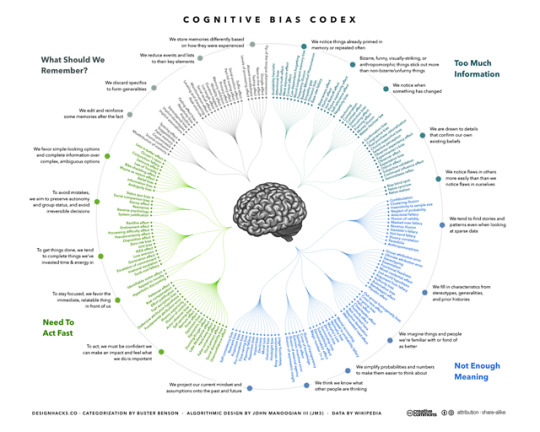
https://de.m.wikipedia.org/wiki/Liste_von_kognitiven_Verzerrungen Liste von kognitiven Verzerrungen Wikimedia-Liste Diese Liste enthält kognitive Verzerrungen (englisch cognitive bias oder cognitive illusions). Eine kognitive Verzerrung ist ein kognitionspsychologischer Sammelbegriff für systematische fehlerhafte Neigungen beim Wahrnehmen, Erinnern, Denken und Urteilen. Sie bleiben meist unbewusst und basieren auf kognitiven Heuristiken. Inhaltsverzeichnis Liste Bearbeiten Übersicht kognitiver Verzerrungen Diese Liste ist eine Auswahl bekannter kognitiver Verzerrungen und erhebt keinen Anspruch auf Vollständigkeit. Name der kognitiven Verzerrung Beschreibung Ankerheuristik, auch anchoring bias Die Tatsache, dass Menschen bei bewusst gewählten Zahlenwerten von momentan vorhandenen Umgebungsinformationen beeinflusst werden, ohne dass ihnen dieser Einfluss bewusst wird.[1] Attributionsfehler, auch correspondence bias Die Neigung, die Ursache für ein beobachtetes Verhalten zu oft in (feststehenden) „Charaktereigenschaften“ der handelnden Person und zu selten in den (variablen) Merkmalen der jeweiligen Situation zu suchen. Backfire-Effekt Die Neigung, Fakten, die der eigenen Überzeugung widersprechen, als Bestätigung der eigenen Überzeugung zu betrachten. Belief-Bias, auch Überzeugungsbias Die Tendenz zu glaubwürdigen Schlussfolgerungen, unabhängig davon, ob sie logisch korrekt sind.[2] Bestätigungsfehler, auch confirmation bias Die Neigung, Informationen so auszuwählen und zu interpretieren, dass sie die eigenen Erwartungen erfüllen.[3] bias blind spot Die Tendenz, sich für unbeeinflusst zu halten (Verzerrungsblindheit). Clustering-Illusion, siehe auch Apophänie und Pareidolie Die Neigung, in Datenströmen Muster zu sehen, selbst wenn gar keine da sind. Cross-Race-Effect Schlechtere Wiedererkennensleistung von Gesichtern, die nicht der eigenen Ethnie entstammen im Vergleich zu Gesichtern der eigenen ethnischen Gruppe Decoy-Effekt Bevorzugung einer von zwei Optionen, wenn eine dritte Option (Köder) hinzugefügt wird, die einer der beiden Optionen in allen Belangen unterlegen ist. Default-Effekt Übermäßige Bevorzugung derjenigen Option, die in Kraft tritt, wenn ein Akteur keine aktive Entscheidung trifft. déformation professionnelle Die Neigung, eine berufs- oder fachbedingte Methode oder Perspektive unbewusst über ihren Geltungsbereich hinaus auf andere Themen und Situationen anzuwenden. Dunning-Kruger-Effekt Die Tendenz von wenig kompetenten Menschen, das eigene Können zu überschätzen und die Kompetenz anderer zu unterschätzen.[4] Emotionale Beweisführung Die Neigung, eine empfundene Emotion als Beweis für eine Annahme zu betrachten. Gender-Bias Die Neigung, generische als spezifische Maskulina zu lesen bzw. Rollenklischees entsprechende Vermutungen anzustellen (z. B. Baggerführer = Mann, Flugbegleiter(in) = Frau). Healthy worker effect auch Healthy worker Bias Die Tendenz, bei epidemiologischen Kohortenstudien einen besseren Gesundheitsstatus der Beschäftigten zu finden, weil Berufstätige einen gewissen Gesundheitszustand aufweisen müssen, um ihre Arbeit ausführen zu können, während in der Gesamtbevölkerung auch krankheitsbedingt Arbeitsunfähige zu finden sind. Halo-Effekt Die Tendenz, von bekannten Eigenschaften einer Person auf unbekannte Eigenschaften zu schließen.[5] Hot-Hand-Phänomen Eine zufällige Häufung von Erfolgen im Sport und Glücksspiel wird als „einen Lauf haben“ oder als „Glückssträhne“ angesehen. Illusorische Korrelation Die fälschliche Wahrnehmung eines Kausalzusammenhangs zweier Ereignisse. impact bias Die psychischen Auswirkungen eines vorgestellten negativen Ereignisses wie Verlust des Arbeitsplatzes oder Trennung vom Partner werden in Dauer und Tiefe systematisch zu stark erwartet.[6] Kontrasteffekt Die intensivere Wahrnehmung einer Information, welche zusammen mit einer im Kontrast stehenden Information präsentiert wird. Kontrollillusion, auch illusion of control Die falsche Annahme, zufällige Ereignisse durch eigenes Verhalten kontrollieren zu können. Law of the instrument Beobachtung, dass Menschen, die mit einem Werkzeug (oder einer Vorgehensweise) gut vertraut sind, dazu neigen, dieses Werkzeug auch dann zu benutzen, wenn ein anderes Werkzeug besser geeignet wäre (auch: „Maslows Hammer“) Post-purchase rationalisation Rechtfertigung des Erwerbs nach dem Kauf einer wenig sinnvollen Sache Recall Bias, auch Erinnerungsverzerrung Fehlerquelle vor allem in retrospektiven Studien. Rückschaufehler, auch hindsight bias Die verfälschte Erinnerung an eigene Vorhersagen, die bezüglich eines Ereignisses getroffen wurden, nach dem Eintreten des Ereignisses. Status-quo-Verzerrung Tendenz der Bevorzugung des Status quo gegenüber Veränderungen. Scope Neglect, auch genannt Scope Insensitivity Das Nichtbeachten der (geringen) Größe eines Problems. Zum Beispiel erklären sich Menschen in einer Studie bereit, im Durchschnitt 78 US-Dollar für die Rettung von 20.000 Vögeln zu bezahlen. Werden sie hingegen zur Zahlungsbereitschaft zur Rettung von 2.000 Vögeln gefragt, kommt im Durchschnitt beinahe der gleiche Wert heraus.[7] Selbstüberschätzung, auch Vermessenheitsverzerrung Die Überschätzung des eigenen Könnens und eigener Kompetenzen. Selbstwertdienliche Verzerrung und Lake-Wobegon-Effekt Verzerrungen, die der Aufrechterhaltung eines positiven konsistenten Selbstbildes dienen. Self-Reference-Effekt Schematisierender Effekt des Selbstkonzepts. Truthahn-Illusion Die Neigung, einen Trend zu extrapolieren, ohne ihn zu hinterfragen. Die Sicherheit wächst permanent mit dem Trend. Daher ist zum Zeitpunkt des Trendbruchs die Sicherheit am größten, ebenso wie der Schock über den Trendbruch. Verlustaversion die Tendenz, Verluste höher zu gewichten als Gewinne. Zwei-Faktoren-Theorie der Emotion Die Neigung, situative Hinweisreize zur Kausalattribution von Emotionen heranzuziehen.
0 notes
Photo
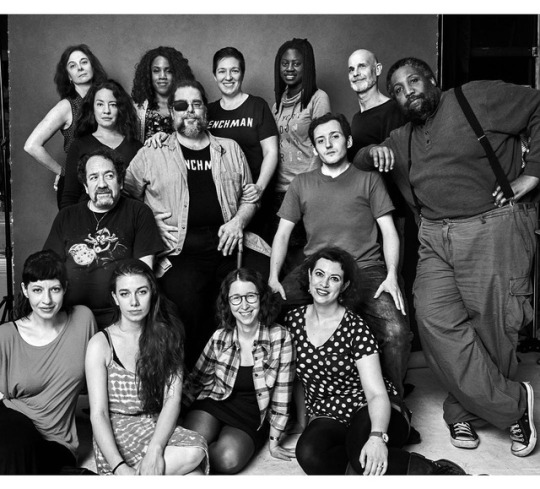
THE COLLISIONWORKERS 2017 creating USEFUL IDIOTS (a farce), ReFUSE (an apophänie), and HARAKIRI KANE AKA DIE! DIE, AGAIN! by @deanhaspiel_art (a sad comedy or funny tragedy), November, @bricktheater "ANGER IS AN ENERGY" photo by Mark Veltman
0 notes
Text
The Theory of Apophenia
Apophenia is the human tendency to perceive meaningful patterns within random data.
The term apparently dates back to 1958, when Klaus Conrad published a monograph titled Die beginnende Schizophrenie. Versuch einer Gestaltanalyse des Wahns ("The onset of schizophrenia: an attempt to form an analysis of delusion"), in which he described in groundbreaking detail the prodromal mood and earliest stages of schizophrenia. He coined the word "Apophänie" to characterize the onset of delusional thinking in psychosis. Conrad's theories on the genesis of schizophrenia have since been partially, yet inconclusively, confirmed in psychiatric literature when tested against empirical findings.
Conrad's neologism was translated into English as "apophenia" (from the Greek apo [away from] + phaenein [to show]) to reflect the fact that a person with schizophrenia initially experiences delusion as revelation.
In 2001 neuroscientist Peter Brugger referenced Conrad's terminology and defined the term as the "unmotivated seeing of connections" accompanied by a "specific experience of an abnormal meaningfulness".
Apophenia has come to imply a universal human tendency to seek patterns in random information, such as gambling.
Pareidolia is a type of apophenia involving the perception of images or sounds in random stimuli.
For example, hearing a ringing phone, while taking a shower. The noise produced by the running water provides a background from which the mind perceives the sound of a phone. A more common example is the perception of a face within an inanimate object—the headlights and grill of an automobile may appear to be "grinning". People around the world see the "Man in the Moon".
People sometimes see the face of a religious figure in a piece of toast or in the grain of a piece of wood.
Another common example is of one standing in a large crowd and perceiving that several people within the crowd are calling one's name.
Overfitting
In statistics and machine learning, apophenia is an example of what is known as overfitting. Overfitting occurs when a statistical model fits the noise rather than the signal. The model overfits the particular data or observations rather than fitting a generalizable pattern in a general population.
Gambler's fallacy
Apophenia is well documented as a rationalization for gambling. Gamblers may imagine that they see patterns in the numbers which appear in lotteries, card games, or roulette wheels.[8] One variation of this is known as the "gambler's fallacy".
Hidden meanings
Fortune-telling and divination are often based upon discerning patterns seen in what most people would consider to be meaningless chance events. The concept of a Freudian slip is based upon what had previously been dismissed as meaningless errors of speech or memory. Sigmund Freud believed that such "slips" held meaning for the unconscious mind (see The Interpretation of Dreams).
References
Conrad, Klaus (1958). Die beginnende Schizophrenie. Versuch einer Gestaltanalyse des Wahns (in German). Stuttgart: Georg Thieme Verlag. OCLC 14620263.
Jump up^ Hambrecht & Häfner (1993). "'Trema, apophany, apocalypse'--is Conrad's phase model empirically founded?". Fortschr Neurol Psychiatr. 61 (12): 418–23. doi:10.1055/s-2007-999113. PMID 8112705.
Jump up^ Mishara, Aaron (2010). "Klaus Conrad (1905–1961): Delusional Mood, Psychosis and Beginning Schizophrenia.". Schizophr Bull. 36 (1): 9–13. doi:10.1093/schbul/sbp144. PMC 2800156. PMID 19965934.
Jump up^ Brugger, Peter. "From Haunted Brain to Haunted Science: A Cognitive Neuroscience View of Paranormal and Pseudoscientific Thought", Hauntings and Poltergeists: Multidisciplinary Perspectives, edited by J. Houran and R. Lange (North Carolina: McFarland & Company, Inc. Publishers, 2001)
Jump up^ Hubscher, Sandra L. "Apophenia: Definition and Analysis". dbskeptic.com. Archived from the original on 2012-07-16. Retrieved 2012-07-16.
Jump up^ Svoboda, Elizabeth (13 February 2007). "Facial Recognition – Brain – Faces, Faces Everywhere". New York Times. Retrieved 3 July 2010.
Jump up^ "Apophenia". Medical-answers.org. Retrieved 2011-06-29.[dead link]
Jump up^ May 28, 2007 at 9:49 pm (2007-05-24). "Apophenia & Illusory Correlation « Paul Xavier Waterstone". Waterstone.wordpress.com. Retrieved 2011-06-29.
Jump up^ Conrad, Klaus (1959). "Gestaltanalyse und Daseinsanalytik". Nervenarzt (30). pp. 405–410.
Jump up^ Shermer, Michael. "Patternicity: Finding Meaningful Patterns in Meaningless Noise". Scientificamerican.com. Retrieved 2011-06-29.
Jump up^ GrrlScientist (29 September 2010). "Michael Shermer: The pattern behind self-deception". London: Guardian. Retrieved 2011-06-29.
Jump up^ "Why Do We Need a Belief in God with Michael Shermer". 2011-08-19.
Jump up^ Luke, David. "Experiential reclamation and first person parapsychology". Journal of Parapsychology, 75, 185–199
Further Reading
Endslay, Mica R. (2004). Simon Banbury, Sébastien Tremblay, ed. A Cognitive Approach To Situation Awareness: Theory and Application (1st ed.). USA: Ashgate Publishing, Ltd. ISBN 0-7546-4198-8.
Gibson, William (2003). Pattern Recognition. New York: G. P. Putnam's Sons. ISBN 978-0-3991-4986-3. OCLC 49894062
0 notes
